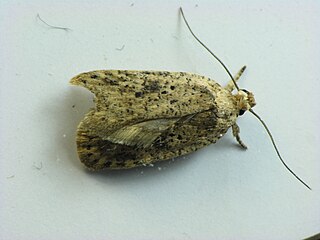| Gonioterma chromolitha | |
|---|---|
| Scientific classification | |
| Kingdom: | |
| Phylum: | |
| Class: | |
| Order: | |
| Family: | |
| Genus: | |
| Species: | G. chromolitha |
| Binomial name | |
| Gonioterma chromolitha (Meyrick, 1925) | |
| Synonyms | |
| |
Gonioterma chromolitha is a moth of the family Depressariidae. It is found in Bolivia. [1]

Moths comprise a group of insects related to butterflies, belonging to the order Lepidoptera. Most lepidopterans are moths, and there are thought to be approximately 160,000 species of moth, many of which have yet to be described. Most species of moth are nocturnal, but there are also crepuscular and diurnal species.

Depressariidae is a family of moths. It has formerly been treated as a subfamily of Gelechiidae, but is now recognised as a separate family, comprising about 2300 species worldwide.

Bolivia, officially the Plurinational State of Bolivia, is a landlocked country located in western-central South America. The capital is Sucre, while the seat of government and financial center is located in La Paz. The largest city and principal industrial center is Santa Cruz de la Sierra, located on the Llanos Orientales, a mostly flat region in the east of the country.
The wingspan is about 24 mm. The forewings are ochreous white, the costal edge pale greyish ochreous, towards the base dark grey. There are three dark indigo-blue spots on the costa, the first two small, at one-fourth and the middle, the third larger, at four-fifths. There is a patch of brownish-grey suffusion covering the dorsal half from one-fourth to the tornus, limited posteriorly by a curved dark coppery-grey shade from the third costal spot. The plical and second discal stigmata form suffused coppery-purplish spots, each connected with the dorsum by a dark coppery-purplish shade, some dark purplish suffusion towards the dorsum between these. There is a marginal series of dark indigo-blue dots around the apex and upper part of the termen, the largest above the apex. The hindwings are ochreous whitish, the terminal edge more ochreous tinged. [2]

The wingspan of a bird or an airplane is the distance from one wingtip to the other wingtip. For example, the Boeing 777-200 has a wingspan of 60.93 metres, and a wandering albatross caught in 1965 had a wingspan of 3.63 metres, the official record for a living bird. The term wingspan, more technically extent, is also used for other winged animals such as pterosaurs, bats, insects, etc., and other fixed-wing aircraft such as ornithopters. In humans, the term wingspan also refers to the arm span, which is distance between the length from one end of an individual's arms to the other when raised parallel to the ground at shoulder height at a 90º angle. Former professional basketball player Manute Bol stands at 7 ft 7 in (2.31 m) and owns one of the largest wingspans at 8 ft 6 in (2.59 m).